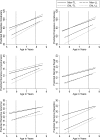The Persistence and Functional Impact of English Language Difficulties Experienced by Children Learning English as an Additional Language and Monolingual Peers
- PMID: 28617919
- PMCID: PMC5831091
- DOI: 10.1044/2017_JSLHR-L-16-0318
The Persistence and Functional Impact of English Language Difficulties Experienced by Children Learning English as an Additional Language and Monolingual Peers
Abstract
Purpose: This study explored whether a monolingual-normed English language battery could identify children with English as an additional language (EAL) who have persistent English language learning difficulties that affect functional academic attainment.
Method: Children with EAL (n = 43) and monolingual English-speaking children (n = 46) completed a comprehensive monolingual-normed English language battery in Year 1 (ages 5-6 years) and Year 3 (ages 7-8 years). Children with EAL and monolingual peers, who either met monolingual criteria for language impairment or typical development on the language battery in Year 1, were compared on language growth between Year 1 and Year 3 and on attainment in national curriculum assessments in Year 2 (ages 6-7 years).
Results: Children with EAL and monolingual peers who met monolingual criteria for language impairment in Year 1 continued to display comparably impaired overall language ability 2 years later in Year 3. Moreover, these groups displayed comparably low levels of academic attainment in Year 2, demonstrating comparable functional impact of their language difficulties.
Conclusion: Monolingual-normed language batteries in the majority language may have some practical value for identifying bilingual children who need support with language learning, regardless of the origin of their language difficulties.
Figures



References
-
- Adams C., Cooke R., Crutchley A., Hesketh A., & Reeves D. (2001). Assessment of Comprehension and Expression 6-11. London, UK: GL assessment.
-
- Babayiğit S. (2014). The role of oral language skills in reading and listening comprehension of text: A comparison of monolingual (L1) and bilingual (L2) speakers of English language. Journal of Research in Reading, 37(S1), S22–S47. https://doi.org/10.1111/j.1467-9817.2012.01538.x
-
- Bedore L. M., & Peña E. D. (2008). Assessment of bilingual children for identification of language impairment: Current findings and implications for practice. International Journal of Bilingual Education and Bilingualism, 11, 1–29. https://doi.org/10.2167/beb392.0
-
- Bialystok E., Luk G., Peets K. F., & Yang S. (2010). Receptive vocabulary differences in monolingual and bilingual children. Bilingualism: Language and Cognition, 13, 525–531. https://doi.org/10.1017/S1366728909990423 - PMC - PubMed
-
- Bishop D. V. M. (2003a). Children's Communication Checklist–Second Edition. London, UK: Pearson.
Publication types
MeSH terms
Grants and funding
LinkOut - more resources
Full Text Sources
Other Literature Sources
Miscellaneous

